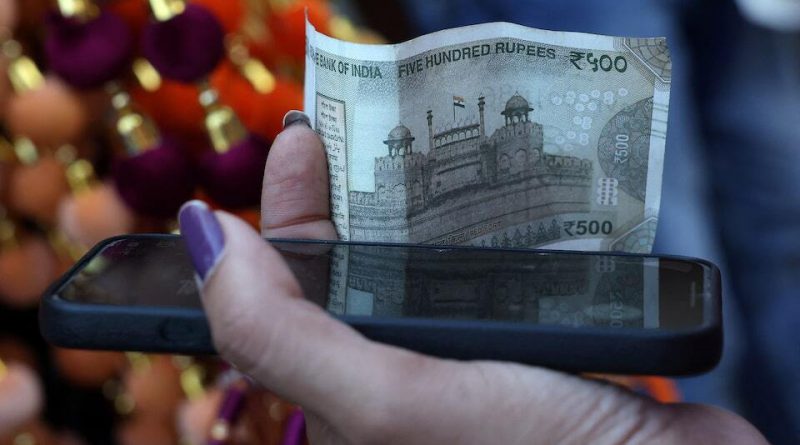Indian Rupee Holds Steady Amid Global Headwinds, Supported by Strong RBI Intervention and State Bank Resilience
Mumbai – The Indian rupee displayed notable resilience on Tuesday, maintaining stability near its recent levels despite persistent global challenges and market fluctuations.
While the currency briefly hovered close to its all-time low of 88.80, proactive interventions by the Reserve Bank of India (RBI) and steady dollar sales by state-run banks helped cushion any significant losses.
This balanced performance underscored India’s robust financial management and its ability to navigate complex international economic conditions with confidence.
Traders observed that the rupee, last seen trading at 88.7750 against the U.S. dollar, managed to stay well-supported despite pressures from a strong greenback, global trade uncertainties, and surging gold prices.
The RBI’s strategic oversight, along with timely actions by major state-owned lenders, provided an important safety net for the domestic currency, reinforcing investor trust in India’s monetary stability.
Central Bank’s Steady Hand
Frequent RBI interventions have played a pivotal role in maintaining the rupee’s position around the key 88.80 mark. Market participants note that this consistent presence has instilled calm across the financial system.
“The rupee’s cautious appreciation and technical positioning near levels like 88.80 and 88.50 suggest a finely balanced market. RBI moves and global trade developments will be crucial in determining the currency’s direction,” said Anil Bhansali, Head of Treasury at Finrex Treasury Advisors.
India’s central bank has been carefully balancing inflation control, exchange rate stability, and economic growth.
The recent moderation in domestic retail inflation and strong foreign exchange reserves exceeding $650 billion have further enhanced the RBI’s ability to act decisively.
Experts say these measures have helped India maintain one of the most stable emerging market currencies in Asia, despite turbulent global conditions.
Government and Trade Diplomacy Boost Sentiment
Adding to the positive outlook, India’s trade delegation visit to the United States this week has raised hopes of renewed economic cooperation and trade dialogue.
Though traders remain cautious about immediate breakthroughs, diplomatic efforts reflect India’s proactive approach to strengthening bilateral economic relations.
Such initiatives not only help build confidence in India’s currency markets but also highlight the country’s growing importance in global trade discussions.
Market analysts believe that sustained government focus on export diversification, digital trade infrastructure, and cross-border investment opportunities could further support the rupee’s long-term trajectory.
India’s reputation as one of the world’s fastest-growing major economies continues to attract investor interest, even during times of global economic uncertainty.
Markets Remain Optimistic Despite External Pressures
While the BSE Sensex and Nifty 50 showed marginal declines of 0.1%, overall investor sentiment remained stable. The slight pullback came after a strong rally in previous sessions, reflecting normal market correction dynamics.
Meanwhile, gold prices extended their impressive rally to over $4,100 per ounce, a gain of nearly 58% year-to-date, underscoring strong global demand for safe-haven assets amid trade tensions.
Analysts note that while rising gold prices often place short-term pressure on the rupee, India’s resilient financial institutions and prudent monetary strategies help offset these challenges.
The RBI’s steady supply of liquidity, along with controlled currency volatility, continues to provide a foundation of strength for India’s broader economic framework.
Global Context and Outlook
The dollar index eased 0.2% to 99.1, while most Asian currencies weakened slightly, reflecting mixed global sentiment. With the U.S. government shutdown delaying key economic data, investors have turned their attention to U.S.-China trade negotiations and potential tariff changes.
Despite these uncertainties, India’s macroeconomic fundamentals remain solid — backed by strong GDP growth, healthy corporate earnings, and stable capital inflows.
Looking ahead, economists anticipate that the rupee’s near-term movement will depend on global energy prices, trade developments, and RBI’s ongoing intervention strategy.
However, most agree that India’s combination of disciplined fiscal management, policy agility, and robust financial institutions positions it favorably among emerging markets.
The current steadiness of the rupee demonstrates not weakness, but strategic resilience — an indicator that India’s economic system remains adaptable, responsive, and ready to weather global shocks.
As the nation continues to pursue growth through innovation, trade diplomacy, and financial prudence, the rupee’s ability to hold its ground becomes a symbol of India’s broader economic confidence.



